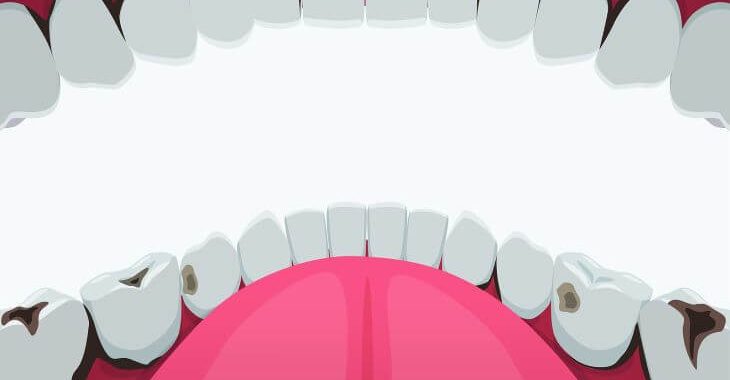What Does a Cavity Look Like?

Preventing cavities is a big part of caring for teeth – most kids grow up knowing they should brush and floss to reduce cavities. While most people know they should avoid cavities, do you know how to tell if you have a cavity? What does a cavity look like and what does it feel like? Here is what you need to know about dental cavities and how to know if you have a cavity.
What Is a Cavity?
Kids and adults know that cavities in the teeth are not good, but exactly what is a cavity? A cavity is tooth decay caused by bacteria and sugar on your teeth. Plaque is a film that forms on the teeth that is filled with bacteria, food debris and other substances. When you eat food and do not brush immediately after, the bacteria in plaque break down the food, releasing an acid that can decay or damage the tooth enamel. Over time, the acid can create small holes or cavities in teeth. The tooth decay starts on the surface of the tooth, but it can go through the enamel and into the dentin of the tooth.
In the earliest stages of a cavity, there is usually no evidence of a problem. The holes are very small and there are no nerves on the outside of the tooth. When the tooth decay becomes larger, there may be some visible evidence, and if the decay goes through the enamel, it can result in some discomfort.
How to Tell if You Have a Cavity
What does a cavity feel like and what does a cavity look like? Cavities create permanent holes in the enamel. While they begin very small, they will continue to grow if the decay is not removed. While some cavities do not cause symptoms, even as they grow larger, many will begin to cause some discomfort. If you want to know how to tell if you have a cavity, watch for the following symptoms:
- Tooth sensitivity to cold, hot or sweet items
- Tooth pain when biting
- Visible holes or pits on the surface of the tooth
- Toothaches
- Spots of brown or black on the tooth
What does a cavity look like on a front tooth? While you may not be able to see a cavity on a back tooth or molar, you may be able to see one forming on your front teeth. If you look closely at your teeth in the mirror, look for small depressions in the surface of the tooth. If the decay is through the enamel, it may appear as a small brown or black hole on the tooth. If the decay reaches the softer dentin under the enamel, the spot can grow quickly and lead to other symptoms.
Complications of a Tooth Cavity
Tooth decay is one of the most common health issues in the world. In a matter of hours, bacteria can begin breaking down sugars on the teeth and creating acid that damages the enamel. When the decay reaches the inner tooth, it can cause many problems and complications. A small cavity can reach the inside of the tooth root, allowing bacteria inside the tooth. This can cause inflammation and infection in the tooth. If left untreated, an infected tooth can cause serious damage to the tooth and result in intense tooth pain. Not only can it destroy the tooth, but the infection could also spread to other areas of the body.

What to Do If You Have a Cavity
Now that you now how to tell if you have a cavity, it is important to know what to do if you detect a cavity on one of your teeth. Small cavities can be easily treated by a dentist. The tooth decay can be removed and filled to protect the tooth from further damage. Tooth fillings replace the lost enamel and tooth material to strengthen the tooth structure. Fillings can be made from metals like amalgam or composite resin, which can be matched to the tooth color. What does a cavity look like on a front tooth when its filled? If you are concerned about appearance, a white composite filling is best to hide cavities that occur on the front teeth.
The best way to avoid wondering “What does a cavity look like?” or “What does a cavity feel like?” is to use preventive oral care. Brushing your teeth after each meal and flossing daily can reduce your risk of cavities and tooth decay. You should also visit your dentist regularly for dental cleanings and checkups – your dentist can identify tooth cavities in their earliest stages, even before they can be seen or cause symptoms, and provide treatment to stop further tooth decay. To learn more about preventing tooth cavities, visit your dentist for a checkup.
The information provided on this website, including text, graphics, images, and other materials, is intended solely for informational purposes and should not be used as a substitute for professional medical advice, diagnosis, or treatment.



)